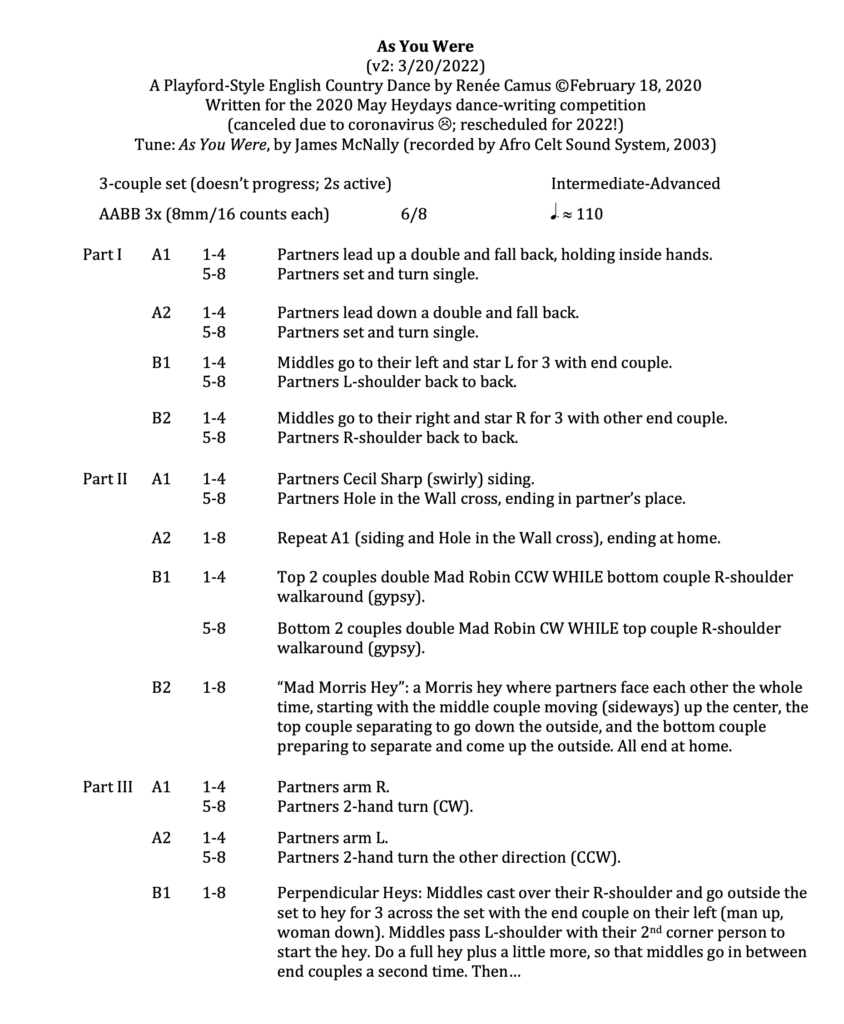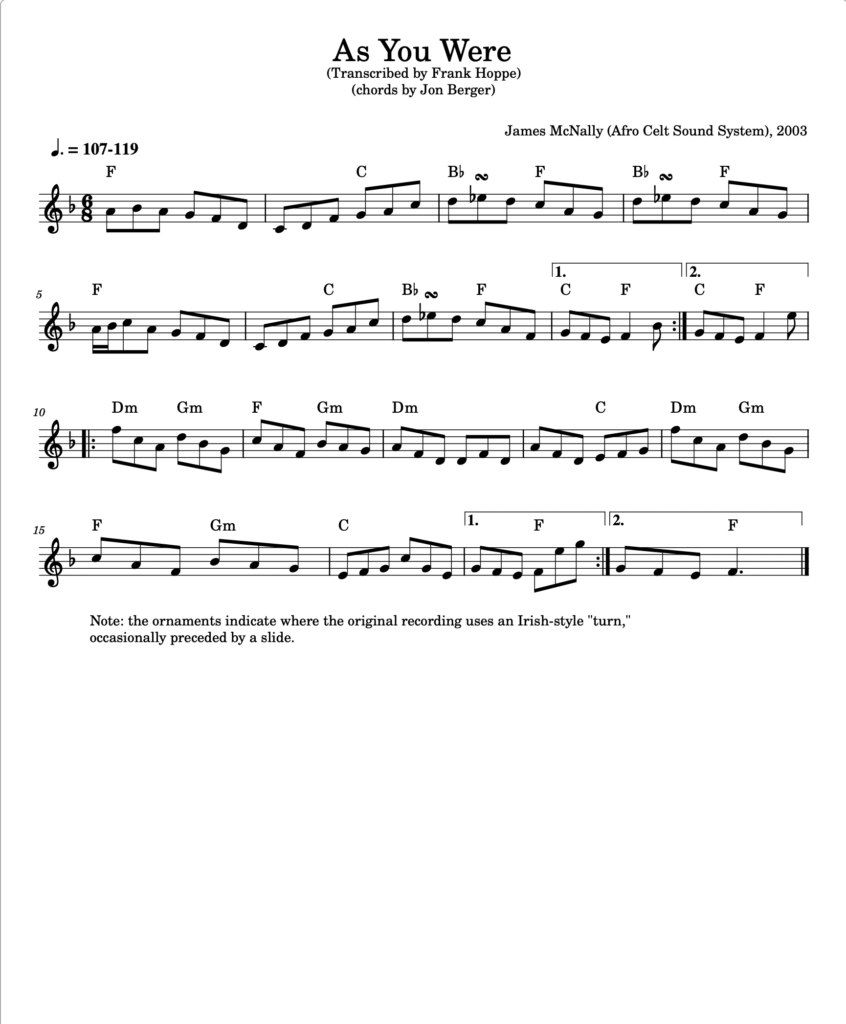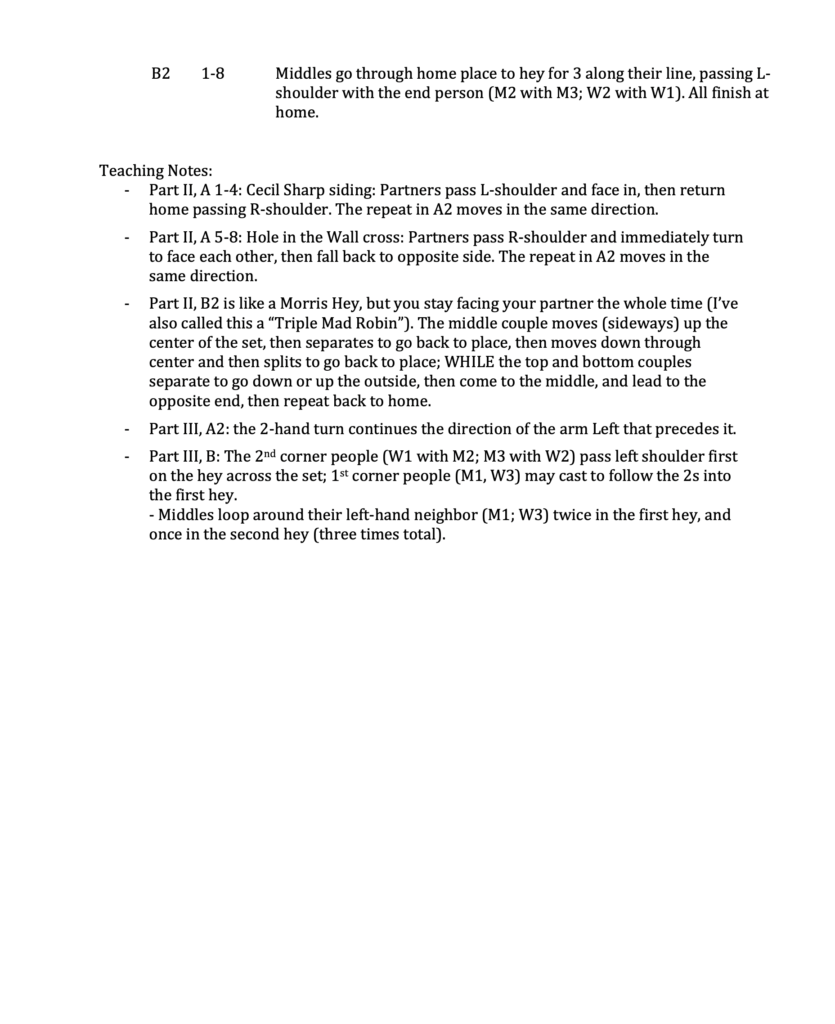As You Were
TL;DR: This dance, titled “As You Were,” is a Playford-style, 3-couple set dance written for the May Heydays dance-writing competition in England, which took place on May 1, 2022. I’m delighted to say it won first place! 🙂
(jump to instructions.)
I wrote this dance in February 2020 and tested it—and then had to sit on it for two years because of the pandemic (of course, as so many dancers and choreographers had to do). It was written for a dance-writing competition sponsored by the May Heydays Festival (formerly Eastbourne International Folkdance Festival) in Great Britain, which was supposed to take place in May 2020. They were finally able to hold the event from April 29 through May 1, 2022. I wasn’t able to attend, but fortunately I didn’t have to be there to participate in the contest.
The rules for the 2022 contest dictated that the English country dance was to be “‘Playford style,’ by which loose term we mean a dance which might have been published between 1651 and 1801.” The first thing I thought of when I thought “Playford-style” was 3-couple set USA dance (up-a-double, siding, and arming). So that quickly became my framework for the dance. I had a tune that I’d been thinking of working with (more on that below), and with all that, the dance came together very quickly. I wrote it in a couple of hours in the afternoon of February 18, 2020, and then tested it at the Dance Kitchen (an opportunity for callers to practice and choreographers to test new dances in Pasadena, CA) that evening. It went really well and people enjoyed it, and it was basically finished! I wanted to test it more so that I could dance it in each position (it’s a non-progressive set), and I wanted to clarify the direction of one or two turns, but otherwise, it was finished. Of course, I then had to wait two years before I could test it again, but it eventually worked out. 🙂
I submitted it to the contest in 2022, and they danced it at the event. According to their website:
“On Sunday morning [caller Andrew Swaine] walked each dance through, called it, then controlled the process of getting comments on each dance after it had been danced, making sure people had their say without anyone monopolising the discussion. . . . Daisy Black was recording all the votes in a spreadsheet, so that at the end — after Mecki had told us who each of the eight was by (choreographers from England, the USA and Australia) — Andrew could immediately announce the top three dances.”
“Thirty or more people were there to try out each dance, discuss it, and then vote on it at one of four levels (or abstain):
1. Would avoid: In its current form, I’d sit out this dance if I knew it was being called.
2. Indifferent: I’d do this dance but it wouldn’t be one of my favourites.
3. Enjoyable: I’d enjoy doing this dance again if it was called.
4. Exceptional: This is a great dance I’ll be talking about – I’d actively ask to do it again or would call it myself.
(I encourage you to visit the May Heydays competition website and read all the information there, and check out the other dances.)
I’m delighted to say, my dance WON! I took first place, among a very impressive group of dances from well-known callers and choreographers. I’m shocked and humbled, and so pleased. 🙂
Here’s what the caller Andrew Swaine said about the dance (from the competition website):
“A three part dance following an early Playford structure that was less challenging than its length would suggest thanks to a good storyline. The band loved the tune and considered it worth its challenges. The “Mad Morris Hey” was a great idea and well received, although I found that walking an actual Morris hey first to explain the path confused more people than it helped! Some felt the stars in the first figure would have been better going right first, and the transition from Mad Robin to Mad Morris Hey wasn’t as good from all positions, but overall there was enough magic in this dance to get our only majority “Exceptional” vote.”
Caller Andrew Swaine, at the May Heydays dance-writing competition
This past June, caller extraordinaire Bruce Hamilton taught the dance during his advanced class at Hey Days (in Northern California), and I was in attendance. It was such a thrill! He called it “a new edifice made from old bricks.” I love that. Thanks Bruce!
(I hope to share a video from that class here soon.)
The tune for the dance is “As You Were” (I kept the title; it fits perfectly for my dance), by James McNally of the band Afro Celt Sound System. It’s from their 2003 album, “Seed,” which is wonderful, and I highly recommend it to everyone. I had to edit the track and slow it down for my dance, and it took some doing to find the band members and get permission to use the music, and I’m so glad I was able to do so. Huge thanks to them, particularly Simon Emmerson, James McNally, and Martin Russell.
Thanks also to Frank Hoppe for transcribing the tune, and to Jon Berger for the chording.
As You Were
A Playford-Style English Country Dance by Renée Camus
©February 18, 2020
Written for the 2020 May Heydays dance-writing competition
(canceled due to coronavirus; rescheduled for 2022!)
Tune: As You Were, by James McNally (recorded by Afro Celt Sound System, 2003)
Used with permission.
3-couple set (doesn’t progress; 2s active)
Intermediate-Advanced
AABB 3x (8mm/16 counts each)
6/8 (q~110)
| Part I | A1 | 1-4 | Partners lead up a double and fall back, holding inside hands. | |
| 5-8 | Partners set and turn single. | |||
| A2 | 1-4 | Partners lead down a double and fall back. | ||
| 5-8 | Partners set and turn single. | |||
| B1 | 1-4 | Middles go to their left and star L for 3 with end couple. | ||
| 5-8 | Partners L-shoulder back to back. | |||
| B2 | 1-4 | Middles go to their right and star R for 3 with other end couple. | ||
| 5-8 | Partners R-shoulder back to back. | |||
| Part II | A1 | 1-4 | Partners Cecil Sharp (swirly) siding. | |
| 5-8 | Partners Hole in the Wall cross, ending in partner’s place. | |||
| A2 | 1-8 | Repeat A1 (siding and Hole in the Wall cross), ending at home. | ||
| B1 | 1-4 | Top 2 couples double Mad Robin CCW WHILE bottom couple R-shoulder walkaround. | ||
| 5-8 | Bottom 2 couples double Mad Robin CW WHILE top couple R-shoulder walkaround. | |||
| B2 | 1-8 | “Mad Morris Hey”: a Morris hey where partners face each other the whole time, starting with the middle couple moving (sideways) up the center, the top couple separating to go down the outside, and the bottom couple preparing to separate and come up the outside. All end at home. | ||
| Part III | A1 | 1-4 | Partners arm R. | |
| 5-8 | Partners 2-hand turn (CW). | |||
| A2 | 1-4 | Partners arm L. | ||
| 5-8 | Partners 2-hand turn the other direction (CCW). | |||
| B1 | 1-8 | Perpendicular Heys: Middles cast over their R-shoulder and go outside the set to hey for 3 across the set with the end couple on their left (man up, woman down). Middles pass L-shoulder with their 2nd corner person to start the hey. Do a full hey plus a little more, so that middles go in between end couples a second time. Then… | ||
| B2 | 1-8 | Middles go through home place to hey for 3 along their line, passing L-shoulder with the end person (M2 with M3; W2 with W1). All finish at home. | ||
Teaching Notes:
- Part II, A 1-4: Cecil Sharp siding: Partners pass L-shoulder and face in, then return home passing R-shoulder. The repeat in A2 moves in the same direction.
- Part II, A 5-8: Hole in the Wall cross: Partners pass R-shoulder and immediately turn to face each other, then fall back to opposite side. The repeat in A2 moves in the same direction.
- Part II, B2 is like a Morris Hey, but you stay facing your partner the whole time (I’ve also called this a “Triple Mad Robin”). The middle couple moves (sideways) up the center of the set, then separates to go back to place, then moves down through center and then splits to go back to place; WHILE the top and bottom couples separate to go down or up the outside, then come to the middle, and lead to the opposite end, then repeat back to home.
- Part III, A2: the 2-hand turn continues the direction of the arm Left that precedes it.
- Part III, B: The 2nd corner people (W1 with M2; M3 with W2) pass left shoulder first on the hey across the set; 1st corner people (M1, W3) may cast to follow the 2s into the first hey.
– Middles loop around their left-hand neighbor (M1; W3) twice in the first hey, and once in the second hey (three times total).
See more of my English country dance choreographies.


